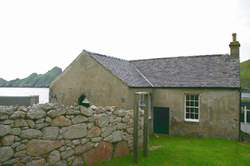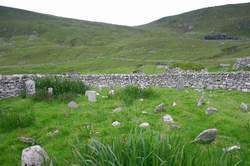Abandoned Communities ..... St Kilda
One skill surprisingly lacking on St Kilda was the ability to row. George Atkinson, mentioned above in relation to his landing on Boreray, wrote that "They pull six oars at a time, two men sitting on the same bench, but as their oars are inconceivably heavy and clumsy, and they ingeniously contrive never to dip two of them together, the progress of the boat is accompanied by a continued splash".
Until the early nineteenth century not a lot changed on St Kilda. The major changes that then began to occur were associated with a gradual increase in the type and frequency of contact with the world at large. In matters of religion, for example, the people of St Kilda had for centuries practised the Christian faith, with a minister being based on Hirte from 1704. However, in the early 1840s, guided by the minister Neil MacKenzie, there was a major religious revival, a central feature of which was the public proclamation of individual sinning, repentance, and the seeking of forgiveness. Very soon afterwards, in 1843, the people of St Kilda chose to affiliate themselves with the Free Church of Scotland, a move that resulted in an obligation to spend many hours, especially on Sundays, engaged in prayer and worship, and a clampdown on behaviour not approved of by the Free Church. On Sundays in particular card games were prohibited and topics allowed during conversation were very much circumscribed. This process reached its highest point between 1865 and 1889 when the minister was John MacKay, a man described by John Sands as "a well meaning but feeble-minded, irresolute but domineering fanatic".
John Sands, Out of the World; or Life in St Kilda, MacLachlan & Stewart, 1877.
The requirement to adhere to regular religious observation disrupted the islanders' patterns of work. Fishing outings on a Wednesday evening, for example, had to be cancelled as a prayer meeting was held at that time. For the first time a form of hierarchy was introduced into St Kildan society, as the minister appointed elders, whose duties included bringing to the minister's attention infringements of the church's code of conduct. Above all, the fun seems to have gone out of life on St Kilda. Music and dancing had been enjoyed for centuries, but were now forbidden. Even in church no musical instruments were permitted, the singing being restricted to psalms that were begun by striking a tuning fork.
For more information on this gloomy topic see Tom Steel, The Life and Death of St Kilda, Fontana 1975, chapter 6. This superb book, by the way, can usually be bought through Amazon for 25p, but you may have to pay £2.75 for postage.
With the ministers came education. The objectives included the acquisition of literacy skills and of the use of the English language. At least in regard to the latter objective not much headway seems to have been made, as when the national census was taken in 1861 it was found that only two of the islanders could speak English, and they had both been born elsewhere.
The third external influence that presumably contributed to the changes taking place in St Kilda was the marked increase in tourism during the nineteenth century. The contrast between the wealth of their visitors and their own simple existence would have been evident to the people of St Kilda, and from the tourists they would have begun to gain a more informed picture of life elsewhere in Great Britain. In addition they started to offer socks, cardigans, and other manufactured items for sale to the tourists. In this way money came to circulate among the islanders, and with it the notion that one family might have an economic advantage over others.
These changes had obvious effects on the social structure and way of life of St Kilda. They may also have had marked psychological consequences. In particular the people of St Kilda were presented with a view of themselves as inferior, uneducated, and sinful, and it would be most surprising if they did not absorb this view into their own perception of themselves.
Until the early nineteenth century not a lot changed on St Kilda. The major changes that then began to occur were associated with a gradual increase in the type and frequency of contact with the world at large. In matters of religion, for example, the people of St Kilda had for centuries practised the Christian faith, with a minister being based on Hirte from 1704. However, in the early 1840s, guided by the minister Neil MacKenzie, there was a major religious revival, a central feature of which was the public proclamation of individual sinning, repentance, and the seeking of forgiveness. Very soon afterwards, in 1843, the people of St Kilda chose to affiliate themselves with the Free Church of Scotland, a move that resulted in an obligation to spend many hours, especially on Sundays, engaged in prayer and worship, and a clampdown on behaviour not approved of by the Free Church. On Sundays in particular card games were prohibited and topics allowed during conversation were very much circumscribed. This process reached its highest point between 1865 and 1889 when the minister was John MacKay, a man described by John Sands as "a well meaning but feeble-
The requirement to adhere to regular religious observation disrupted the islanders' patterns of work. Fishing outings on a Wednesday evening, for example, had to be cancelled as a prayer meeting was held at that time. For the first time a form of hierarchy was introduced into St Kildan society, as the minister appointed elders, whose duties included bringing to the minister's attention infringements of the church's code of conduct. Above all, the fun seems to have gone out of life on St Kilda. Music and dancing had been enjoyed for centuries, but were now forbidden. Even in church no musical instruments were permitted, the singing being restricted to psalms that were begun by striking a tuning fork.
For more information on this gloomy topic see Tom Steel, The Life and Death of St Kilda, Fontana 1975, chapter 6. This superb book, by the way, can usually be bought through Amazon for 25p, but you may have to pay £2.75 for postage.
With the ministers came education. The objectives included the acquisition of literacy skills and of the use of the English language. At least in regard to the latter objective not much headway seems to have been made, as when the national census was taken in 1861 it was found that only two of the islanders could speak English, and they had both been born elsewhere.
The third external influence that presumably contributed to the changes taking place in St Kilda was the marked increase in tourism during the nineteenth century. The contrast between the wealth of their visitors and their own simple existence would have been evident to the people of St Kilda, and from the tourists they would have begun to gain a more informed picture of life elsewhere in Great Britain. In addition they started to offer socks, cardigans, and other manufactured items for sale to the tourists. In this way money came to circulate among the islanders, and with it the notion that one family might have an economic advantage over others.
These changes had obvious effects on the social structure and way of life of St Kilda. They may also have had marked psychological consequences. In particular the people of St Kilda were presented with a view of themselves as inferior, uneducated, and sinful, and it would be most surprising if they did not absorb this view into their own perception of themselves.
Four
The church (restored), with the school room attached to it on the right
The cemetery

